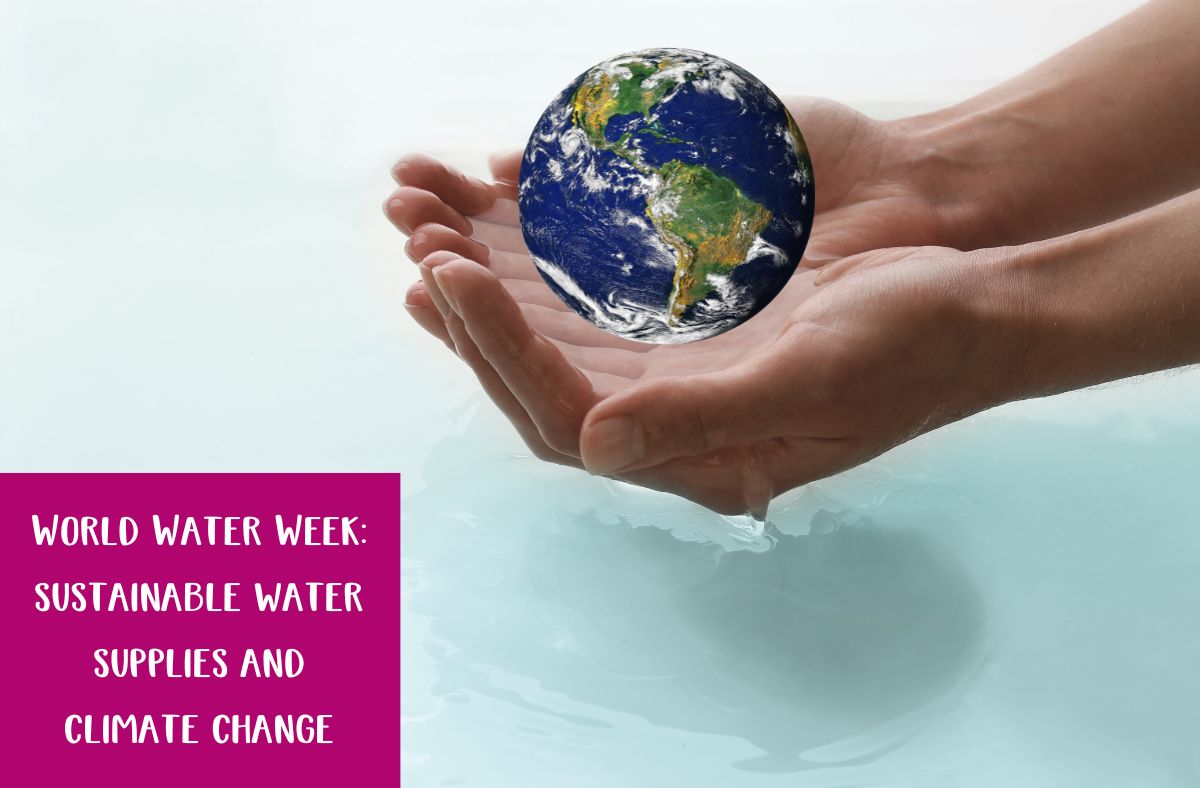
World Water Week: sustainable water supplies and climate change by an Ethical Corporate Gifting Company
Today is the start of World Water Week and at Social Stories Club we have taken time out of packing all your sustainable hampers to educate on water issues around the world. Homes, businesses, and industries all need water to thrive. As the climate continues to change, the accessibility and quantity of water is also changing. Climate change has several direct and indirect effects on water supply that are expected to become more prominent in the coming years.
These effects include natural phenomena such as drought and precipitation patterns as well as indirect consequences such as deforestation which can lead to an increase in wildfires. Understanding the implications of climate change on water supply is important so we can take proactive steps to mitigate its effects. This article will discuss what is currently being done to combat these negative impacts, as well as what you can do personally to help mitigate them.
Climate change is having a big impact on the world, especially when it comes to water supply. As the planet continues to get hotter, ice caps and glaciers are shrinking at an alarming rate. This is leading to a decrease in the amount of fresh water available for human consumption—not just now, but also into the future.
We so often take clean drinking water for granted that it can easily become an afterthought. But this natural resource is becoming increasingly scarce as a result of human negligence combined with the effects of climate change.
Water is the basis of life on earth. Climate change is going to have a big impact on how much water we have available, where it comes from and how we use it.
The quantity and quality of water is set to change in our world as a result of climate change. But there are things that we can do about it! If you are looking to explore our range of sustainable hampers you are in the wrong place but if you are looking to find out exactly how climate change will affect the water supply, what you can do about it, and some best practices for your home or business, you are in the right place!
Climate Change and Water Supply
Water is an essential part of our daily lives. It is used for drinking and sanitation, for growing food, for energy production, to maintain ecosystems, and in many other ways. However, water resources are not evenly distributed. Places where water is abundant are likely to see a decrease in water supply as the climate changes. Places that are already dry are expected to experience an even greater decrease in water supply. In addition to these supply issues, water demand is also expected to increase in many areas due to the changing climate. Changes in species and ecosystems are expected to alter water demand. Increased temperatures and changes in rainfall patterns could increase demand for water in some areas, while decreasing it in others. The timing of water availability and water quality will also be affected by climate change.
Drought
Drought is the most direct effect of climate change on water supply, and it is expected to become more prevalent in many places over the next few decades. Precipitation and streamflow are expected to decrease in many areas, and there is a chance of more frequent and severe droughts in regions that are already drought-prone. The areas most susceptible to drought include the southwestern United States, the Mediterranean region, southern Africa, and Australia. Drought is also expected to increase in many areas due to the decreased snowpack in mountainous regions and the reduced availability of water in aquifers. These impacts of climate change on water supply can be mitigated by investing in water infrastructure such as reservoirs and canals.
Rainfall Patterns
Climate change is also expected to shift rainfall patterns in many areas. Dry areas are expected to become drier and wet areas are expected to become wetter. This means the timing of water availability will also change in many areas. The timing of peak flows in rivers is expected to shift as well. This could have some benefits such as increasing the amount of freshwater available in areas that have shortages during certain times of the year. However, it could also increase flood risk. These patterns are projected to occur mainly in the mid-latitudes. The areas most likely to experience a shift in rainfall patterns include the western United States, southern Brazil, southern Africa, and Australia.
Changing Watershed Conditions and Shifting Aquifer Conditions
Climate change can also affect the amount of water that is available in different watersheds and aquifers. As temperatures rise, more water is expected to evaporate. In addition, changes in rainfall patterns could lead to less water flowing into watersheds or aquifers. These changes could lead to less freshwater available in many areas. The areas where watershed conditions are expected to be most affected include the western United States, Amazonia, and northern Argentina.
The amount of freshwater stored in aquifers could also be affected by climate change. As the ground becomes warmer, more water is expected to be released from aquifers. This could lead to less freshwater available for people who rely on aquifers for water. The areas where aquifer conditions are expected to be most affected include the Southeast United States, the Middle East, and northern Africa.
Ecological Implications of Climate Change on Water Supply
Changes to the ecological systems of a region can also impact water supply. For example, changes in the timing of snowmelt could lead to less water being available during the growing season in some areas. This could lead to lower crop yields in some areas, depending on how the crops are irrigated. The areas most likely to experience these ecological changes are the northern and central Great Plains, the Rocky Mountains, the Southwest United States, southern Brazil, and northern Argentina.
Changes in regional temperatures and rainfall could also lead to increased water demand in many ecosystems. For example, many aquatic ecosystems are expected to experience an increase in average temperature, which could increase the amount of water that is needed for survival. The areas where ecological changes are expected to have the greatest effect on water supply include the northern and central Great Plains, the Rocky Mountains, the Southwest United States, southern Brazil, and northern Argentina.
What is Being Done to Combat the Effects of Climate Change on Water?
As we have seen, climate change has a negative impact on water supply in many places. However, we can take action to mitigate these effects. One way to do this is through integrated water resource management. This is a process in which stakeholders work together to plan for and adapt to changes in water supply. It can be used to help people and ecosystems adapt to altered water supply as well as to prevent water-related issues (such as pollution) from occurring in the first place.
Other ways that we can combat the effects of climate change on water supply include increasing water efficiency, adapting water infrastructure, and investing in research and development to create new technologies that can help us reduce our water footprint. Many of these actions require cooperation between different stakeholders, so it is important to create collaborative environments where people can work together to find solutions to these problems.
Who are most effected by water shortages?
Anyone can be effected by water shortages in some way, but certain groups are more likely to be affected by them. People who rely on surface water for drinking water, for example, are especially at risk. This includes people who live in areas with limited groundwater, people who do not have access to groundwater, and people who rely on surface water that is threatened by drought. People who rely on hydropower for electricity are also more likely to be affected by water shortages. Finally, people who rely on ecosystems for food or other resources are also at an increased risk of water shortages.
How water shortages are effecting communities?
Water shortages can have many different effects on communities. They can lead to a drop in crop yields, which can affect food supply. They can increase the risk of water-related health issues such as diseases and infections. They can also lead to a decrease in hydropower production, which can impact the availability of or cost of electricity. In addition, water shortages can cause conflict between different groups. Communities that rely on water resources that are being adversely affected by climate change are likely to experience at least one of these effects.
Will areas run out of fresh water?
Most areas will not run out of fresh water, but some might. Areas that rely on aquifers that are being depleted will eventually run out of groundwater. Areas that rely on surface water are also at risk of running out. When there is less water flowing into an area, there is less water to move out of the area. This means that less water is available to be reused or to flow into other areas. When water supply is below demand, areas rely on groundwater reservoirs or other methods of water storage to ensure that they have enough water. However, these storage systems are not limitless. Eventually, they will be depleted, and people will need to find new ways to ensure that they have enough water.
Conclusion
Climate change is expected to have a negative impact on water supply in many places. It is important to take action to combat these effects so that we can make sure people have enough water. These efforts can include investing in water infrastructure, increasing water efficiency, and creating collaborative environments where people work together to find solutions to these problems.
People who rely on surface water for drinking water, for example, are especially at risk. Communities that rely on water resources that are being adversely affected by climate change are also likely to experience negative effects. Finally, when water supply is below demand, areas rely on groundwater reservoirs or other methods of water storage to make sure they have enough water.
If you are interested in more information about our sustainable gift hampers, corporate gifting as a strategy, sustainability and social enterprise - join our newsletter. If you want to build your own gift to send to a friend, you can introduce someone new to social enterprise. If you are looking for bespoke corporate gifts for Christmas that are sustainable check our our corporate gifting page.
